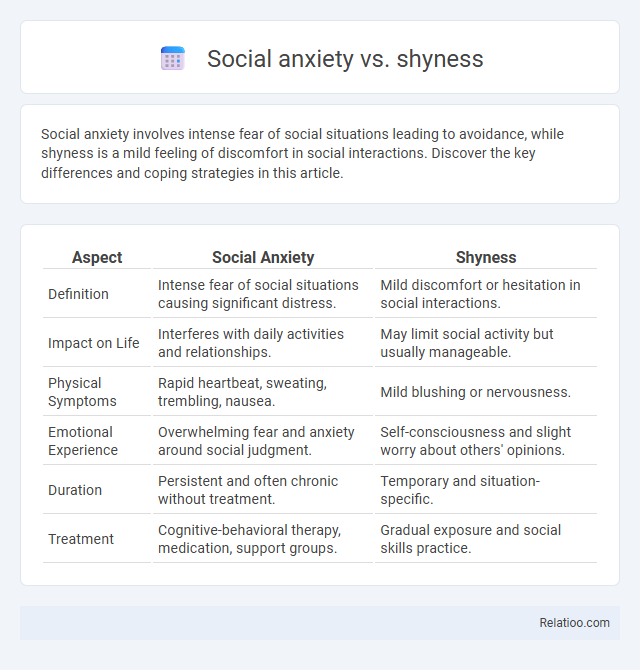Social anxiety involves intense fear of social situations leading to avoidance, while shyness is a mild feeling of discomfort in social interactions. Discover the key differences and coping strategies in this article.
Table of Comparison
| Aspect | Social Anxiety | Shyness |
|---|---|---|
| Definition | Intense fear of social situations causing significant distress. | Mild discomfort or hesitation in social interactions. |
| Impact on Life | Interferes with daily activities and relationships. | May limit social activity but usually manageable. |
| Physical Symptoms | Rapid heartbeat, sweating, trembling, nausea. | Mild blushing or nervousness. |
| Emotional Experience | Overwhelming fear and anxiety around social judgment. | Self-consciousness and slight worry about others' opinions. |
| Duration | Persistent and often chronic without treatment. | Temporary and situation-specific. |
| Treatment | Cognitive-behavioral therapy, medication, support groups. | Gradual exposure and social skills practice. |
Understanding Social Anxiety and Shyness
Social anxiety is a clinical condition characterized by intense fear and avoidance of social situations due to worries about judgment or embarrassment, often impairing daily functioning. Shyness is a personality trait involving discomfort or inhibition in social settings but typically does not cause significant distress or interfere with normal activities. Understanding social anxiety involves recognizing its symptoms--such as excessive self-consciousness and physical signs like rapid heartbeat--distinguishing it from the more common, less severe experience of shyness.
Defining Social Anxiety Disorder
Social Anxiety Disorder is a chronic mental health condition characterized by an intense, persistent fear of being judged or humiliated in social situations, surpassing normal shyness. Unlike shyness, which involves occasional discomfort in social interactions, Social Anxiety Disorder leads to significant avoidance behaviors and distress that impair daily functioning. This disorder often requires clinical diagnosis and treatment, including cognitive-behavioral therapy and medication, to effectively manage symptoms and improve quality of life.
What Is Shyness?
Shyness is a common emotional response characterized by feelings of discomfort or inhibition in social situations, often leading to temporary hesitation or reticence. Unlike social anxiety, which is a diagnosable disorder marked by intense fear and avoidance of social interactions, shyness is generally less severe and does not typically impair daily functioning. Understanding the distinctions between shyness, social anxiety, and related conditions can help you better recognize your experiences and seek appropriate support if needed.
Key Differences Between Social Anxiety and Shyness
Social anxiety involves intense fear and avoidance of social situations due to worry about judgment or embarrassment, whereas shyness is a more common and mild discomfort in social settings without significant impairment. You may experience physical symptoms like sweating or trembling during social anxiety, while shyness generally causes less distress and doesn't interfere heavily with daily life. Understanding these key differences helps in recognizing when professional support for social anxiety might be necessary.
Common Symptoms to Recognize
Social anxiety, shyness, and social phobia share overlapping symptoms such as intense fear of social interactions, rapid heartbeat, sweating, and avoidance of social situations, but social anxiety disorder typically causes more severe distress and impairment. You may notice symptoms like excessive self-consciousness, fear of being judged, trembling, and difficulty speaking in public. Recognizing these common symptoms early allows for better management and effective treatment plans tailored to your specific needs.
Causes and Risk Factors
Social anxiety disorder is primarily caused by a complex interaction of genetic predisposition, brain structure abnormalities such as hyperactivity in the amygdala, and environmental factors including childhood trauma or social rejection. Shyness, while often linked to temperament and learned behavior, does not necessarily involve the intense fear or avoidance seen in social anxiety. Risk factors for social anxiety include a family history of anxiety disorders, early negative social experiences, and overprotective or controlling parenting styles, which differ from the milder influences contributing to general shyness.
Effects on Daily Life
Social anxiety significantly impairs daily functioning by causing intense fear of social situations, leading to avoidance behaviors and reduced participation in work, school, and relationships. Shyness is a milder, personality trait that may cause discomfort but generally does not disrupt daily activities or social interactions. In contrast, social anxiety disorder involves persistent anxiety and physical symptoms that can hinder communication, career advancement, and overall quality of life.
When Shyness Becomes Social Anxiety
Shyness is a common personality trait characterized by discomfort or inhibition in social situations, while social anxiety is a more intense, persistent fear of social interactions that interferes with daily life. When shyness escalates to social anxiety, individuals experience overwhelming worry, avoidance of social settings, and physical symptoms like rapid heartbeat or sweating. Recognizing this shift is crucial for effective treatment, as social anxiety often requires professional intervention such as cognitive-behavioral therapy or medication.
Coping Strategies and Treatment Options
Social anxiety disorder involves intense fear of social situations leading to avoidance and distress, unlike shyness, which is a milder personality trait without significant impairment. Effective coping strategies for social anxiety include cognitive-behavioral therapy (CBT), exposure therapy, and mindfulness techniques, while shyness often benefits from gradual social practice and confidence-building exercises. Your treatment plan may also involve medication such as selective serotonin reuptake inhibitors (SSRIs) if symptoms significantly disrupt daily functioning.
Seeking Help: When to Reach Out
Social anxiety and shyness differ significantly in severity and impact on daily life, with social anxiety often causing intense fear and avoidance of social situations, while shyness is generally milder and less disruptive. Seeking professional help for social anxiety is crucial when feelings of fear interfere with work, relationships, or routine activities, prompting therapy such as cognitive-behavioral therapy (CBT) or medication. Individuals experiencing persistent anxiety that limits social interaction should reach out to mental health providers to receive a proper diagnosis and develop effective coping strategies.

Infographic: Social anxiety vs shyness
 relatioo.com
relatioo.com